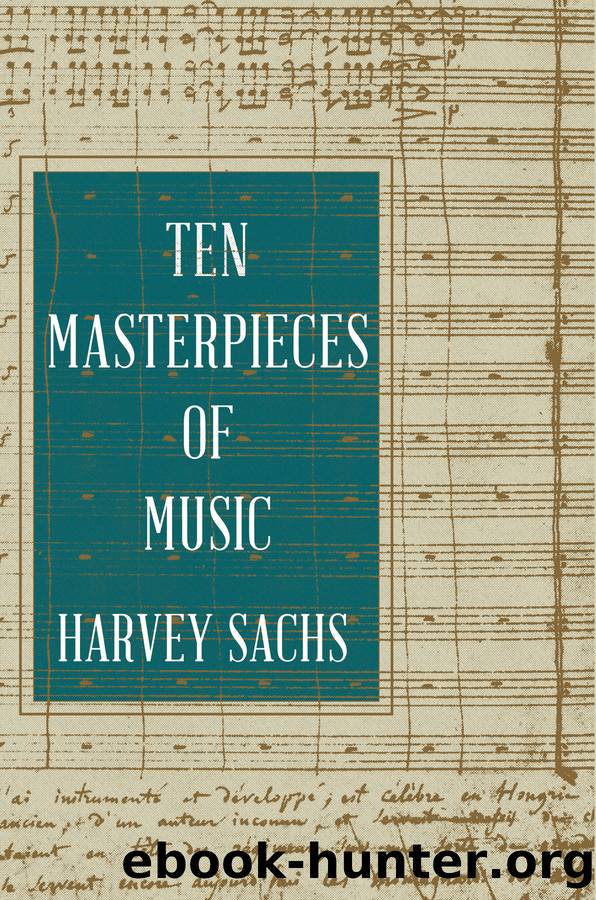Ten Masterpieces of Music by Harvey Sachs

Author:Harvey Sachs [Sachs, Harvey]
Language: eng
Format: epub
Published: 2021-10-08T00:00:00+00:00
A WARM AND AT TIMES shimmering mini-prelude, in C majorâa sort of fantasy on Don Carloâs first-act romanzaâintroduces the third actâs opening scene, which takes place at night in the queenâs garden. Carlo is reading from a note that he believes to be from Elisabetta, inviting him to meet her in the garden at midnight. He trembles with anticipation as Eboli enters, veiled; when she removes her veil, he tries unsuccessfully to cover his shock, and she suddenly realizes, and exclaims, that Carlo is in love with the queen. Rodrigo, who has secretly been watching out for Carlo, suddenly appears, and an energetic trio ends with Eboli departing in a fury and threatening revenge. Carlo expresses doubts about Rodrigoâs friendship for him, since the marquis is now part of the kingâs inner circle, but the doubts are quickly dispelled, the friends embrace, and the scene ends with the orchestra playing the theme of their great duet from the previous act.
The third actâs final scene, commonly known as the auto-da-fè scene, is the most spectacularâthe most grand opéraâlikeâsegment of the entire work. Not surprisingly, it is also the least remarkable part of the opera from the point of view of musical invention and character delineation. And yet it provided Verdi with an opportunity to demonstrate not only his extraordinary ability at organizing and balancing huge masses of singers and instruments but also his lifelong dislike of priests and religious dogma.¶¶ As the entire orchestra attacks its opening, fortissimo barsânominally in E major but initially in an extremely menacing-sounding, insecure A minorâthe curtain opens on crowds gathered in a large square before the Basilica of Our Lady of Atocha, a church that the historical Philip II cherished. The people proclaim their love for and dedication to the monarchy, and they hail Spainâs eternal glory, but their triumphalism gives way to a plodding, low-pitched march of priests who are leading a group of chained heretics to be burned at the stake.
An offstage band, punctuated by interjections from the full orchestra, announces the arrival of the court, including Rodrigo and Elisabetta, and the crowdâs enthusiasm reaches a peak. Filippo emerges from the church, and the common people prostrate themselves before him. The tempo is maestoso (majestic, solemn) as the king âdescends the churchâs steps and goes to take Elisabettaâs hand to continue his walk,â according to the stage instructions. But there is a sudden change to allegro mosso, agitatedly fast, as six Flemish representatives âstep forward, led by Don Carlo, and throw themselves at Filippoâs feet.â The king loudly demands to know who these people are, and, while Carlo is explaining that they are messengers from Brabant and Flanders, the representatives implore the king to have mercy on their people. The king, seconded by the priests, calls them infidels and demands that the guards remove them; this leads into a vast ensembleâsoloists plus chorus and orchestraâin which the members of the court and the assembled commoners plead for the Flemish people, while the king and the priests remain adamant.
Download
This site does not store any files on its server. We only index and link to content provided by other sites. Please contact the content providers to delete copyright contents if any and email us, we'll remove relevant links or contents immediately.
Kathy Andrews Collection by Kathy Andrews(10520)
The remains of the day by Kazuo Ishiguro(7551)
Spare by Prince Harry The Duke of Sussex(4198)
Paper Towns by Green John(4169)
The Body: A Guide for Occupants by Bill Bryson(3802)
Be in a Treehouse by Pete Nelson(3213)
Harry Potter and the Goblet Of Fire by J.K. Rowling(3046)
Goodbye Paradise(2964)
Never by Ken Follett(2881)
Into Thin Air by Jon Krakauer(2701)
The Remains of the Day by Kazuo Ishiguro(2618)
The Genius of Japanese Carpentry by Azby Brown(2609)
The Cellar by Natasha Preston(2595)
Drawing Shortcuts: Developing Quick Drawing Skills Using Today's Technology by Leggitt Jim(2532)
120 Days of Sodom by Marquis de Sade(2438)
Architecture 101 by Nicole Bridge(2350)
The Man Who Died Twice by Richard Osman(2300)
Machine Learning at Scale with H2O by Gregory Keys | David Whiting(2291)
Fairy Tale by Stephen King(2070)
